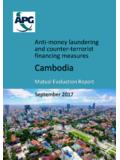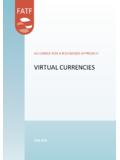Transcription of FATF REPORT Virtual Currencies - fatf-gafi.org
1 fatf REPORT . Virtual Currencies Key Definitions and Potential AML/CFT Risks June 2014. FINANCIAL ACTION TASK FORCE. The Financial Action Task Force ( fatf ) is an independent inter-governmental body that develops and promotes policies to protect the global financial system against money laundering, terrorist financing and the financing of proliferation of weapons of mass destruction. The fatf Recommendations are recognised as the global anti-money laundering (AML) and counter-terrorist financing (CFT) standard. For more information about the fatf , please visit the website: 2014 fatf /OECD. All rights reserved. No reproduction or translation of this publication may be made without prior written permission. Applications for such permission, for all or part of this publication, should be made to the fatf Secretariat, 2 rue Andr Pascal 75775 Paris Cedex 16, France (fax: +33 1 44 30 61 37 or e-mail: Photocredits coverphoto: Thinkstock Virtual Currencies KEY DEFINITIONS AND POTENTIAL AML/CFT RISKS.)
2 CONTENTS. 3. KEY DEFINITIONS:.. 3. Virtual Currency .. 4. Convertible Versus Non-Convertible Virtual Currency .. 4. Centralised Versus Non-Centralised Virtual 5. Virtual Currency System Participants .. 7. LEGITIMATE USES .. 8. POTENTIAL RISKS .. 9. LAW ENFORCEMENT ACTIONS INVOLVING Virtual CURRENCY .. 10. Liberty Reserve ..10. Silk Road ..11. Western Express NOTES .. 13. BIBLIOGRAPHY AND SOURCES .. 15. 2014 1. Virtual Currencies KEY DEFINITIONS AND POTENTIAL AML/CFT RISKS. ACRONYMS. AML/CFT Anti-money laundering / countering the financing of terrorism ECB European Central Bank fatf Financial Action Task Force NPPS Guidance Guidance for a Risk-Based Approach to Prepaid Cards, Mobile Payments and Internet-Based Payment Services 2 2014. Virtual Currencies KEY DEFINITIONS AND POTENTIAL AML/CFT RISKS. Virtual Currencies - KEY DEFINITIONS AND POTENTIAL AML/CFT. RISKS 1. INTRODUCTION. As decentralised, math-based Virtual Currencies particularly Bitcoin2 have garnered increasing attention, two popular narratives have emerged: (1) Virtual Currencies are the wave of the future for payment systems; and (2) Virtual Currencies provide a powerful new tool for criminals, terrorist financiers and other sanctions evaders to move and store illicit funds, out of the reach of law enforcement and other authorities.
3 3 Against this backdrop, this paper builds on the 2013 New Payment Products and Services (NPPS) Guidance ( fatf , 2013) by suggesting a conceptual framework for understanding and addressing the anti-money laundering / countering the financing of terrorism (AML/CFT) risks associated with one kind of internet-based payment system: Virtual Currencies . Specifically, the paper proposes a common definitional vocabulary that clarifies what Virtual currency is and classifies the various types of Virtual currency, based on their different business models and methods of operation, 4 and identifies the participants in typical Virtual currency systems. It also applies risk factors set forth in Section IV (A) of the 2013 NPPS Guidance to specific types of Virtual Currencies to identify potential risks; describes some recent investigations and enforcement efforts involving Virtual currency; and presents a sample of jurisdictions' current regulatory approaches to Virtual currency.
4 While the 2013 NPPS Guidance broadly addressed internet-based payment services, it did not define digital currency, Virtual currency, or electronic money. Nor did it focus on Virtual Currencies , as distinct from internet-based payment systems that facilitate transactions denominated in real money (fiat or national currency) ( , Pay-Pal, Alipay, or Google Checkout). It also did not address decentralised convertible Virtual Currencies , such as Bitcoin. The 2013. Guidance also notes that, [g]iven the developing nature of alternate online Currencies , the fatf . may consider further work in this area in the future (2013 NPPS Guidance, p. 11, para. 29). A short- term typologies project on this basis was initiated with the following objectives: develop a risk-matrix for Virtual Currencies (or perhaps, more broadly, for both Virtual Currencies and e-money);. promote fuller understanding of the parties involved in convertible Virtual currency systems and the way Virtual currency can be used to operate payment systems; and stimulate a discussion on implementing risk-based AML/CFT regulations in this area.
5 This typologies project may lead to policy work by the fatf , the issuance of supplemental guidance for applying a risk-based approach to Virtual Currencies that would incorporate the proposed vocabulary and risk-matrix developed by the typologies project and explain how specific fatf Recommendations apply in the context of Virtual currency. KEY DEFINITIONS: A common set of terms reflecting how Virtual Currencies operate is a crucial first step to enable government officials, law enforcement, and private sector entities to analyse the potential AML/CFT. 2014 3. Virtual Currencies KEY DEFINITIONS AND POTENTIAL AML/CFT RISKS. risks of Virtual currency as a new payment method. As regulators and law enforcement officials around the world begin to grapple with the challenges presented by Virtual Currencies , it has become apparent that we lack a common vocabulary that accurately reflects the different forms Virtual currency may take. The following set of terms is intended to aid discussion between fatf .
6 Members. It is important to note that this vocabulary may change as Virtual currency evolves and as regulators and law enforcement/government officials continue to consider the challenges Virtual Currencies present. Nevertheless, the proposed vocabulary aims to provide a common language for developing conceptual tools to help us better understand how Virtual Currencies operate and the risks and potential benefits they offer. Virtual CURRENCY. Virtual currency is a digital representation5 of value that can be digitally traded and functions as (1) a medium of exchange; and/or (2) a unit of account; and/or (3) a store of value, but does not have legal tender status ( , when tendered to a creditor, is a valid and legal offer of payment) 6 in any jurisdiction. 7 It is not issued nor guaranteed by any jurisdiction, and fulfils the above functions only by agreement within the community of users of the Virtual currency. Virtual currency is distinguished from fiat currency ( real currency, real money, or national currency ), which is the coin and paper money of a country that is designated as its legal tender; circulates; and is customarily used and accepted as a medium of exchange in the issuing country.
7 It is distinct from e-money, which is a digital representation of fiat currency used to electronically transfer value denominated in fiat currency. E-money is a digital transfer mechanism for fiat currency , it electronically transfers value that has legal tender status. Digital currency can mean a digital representation of either Virtual currency (non-fiat) or e-money (fiat) and thus is often used interchangeably with the term Virtual currency . In this paper to avoid confusion, only the terms Virtual currency or e-money are used. CONVERTIBLE VERSUS NON-CONVERTIBLE Virtual CURRENCY. This paper proposes dividing Virtual currency into two basic types: convertible and non-convertible Virtual currency. 8 Although the paper uses non-convertible and closed , and convertible and open as synonyms, it should be emphasised that the notion of convertible currency does not in any way imply an ex officio convertibility ( in the case of gold standard), but rather a de facto convertibility ( because a market exists).
8 Thus, a Virtual currency is convertible only as long as some private participants make offers and others accept them, since the convertibility is not guaranteed at all by law. Convertible (or open) Virtual currency has an equivalent value in real currency and can be exchanged back-and-forth for real currency. 9 Examples include: Bitcoin; e-Gold (defunct); Liberty Reserve (defunct); Second Life Linden Dollars; and WebMoney. 10. Non-convertible (or closed) Virtual currency is intended to be specific to a particular Virtual domain or world, such as a Massively Multiplayer Online Role-Playing Game (MMORPG) or , and under the rules governing its use, cannot be exchanged for fiat currency. Examples include: Project Entropia Dollars; Q Coins; and World of Warcraft Gold. 4 2014. Virtual Currencies KEY DEFINITIONS AND POTENTIAL AML/CFT RISKS. It should be noted that even where, under the terms set by the administrator, a non-convertible currency is officially transferrable only within a specific Virtual environment and is not convertible, it is possible that an unofficial, secondary black market may arise that provides an opportunity to exchange the non-convertible Virtual currency for fiat currency or another Virtual currency.
9 Generally, the administrator will apply sanctions (including termination of membership and/or forfeiture of remaining Virtual currency) to those seeking to create or use a secondary market, contrary to the rules of the currency. 11 Development of a robust secondary black market in a particular non-convertible Virtual currency may, as a practical matter, effectively transform it into a convertible Virtual currency. A non-convertible characterisation is thus not necessarily static. CENTRALISED VERSUS NON-CENTRALISED Virtual Currencies . All non-convertible Virtual Currencies are centralised: by definition, they are issued by a central authority that establishes rules making them non-convertible. In contrast, convertible Virtual Currencies may be either of two sub-types: centralised or decentralised. Centralised Virtual Currencies have a single administrating authority (administrator) , a third party12 that controls the system. An administrator issues the currency; establishes the rules for its use; maintains a central payment ledger; and has authority to redeem the currency (withdraw it from circulation).
10 The exchange rate for a convertible Virtual currency may be either floating . , determined by market supply and demand for the Virtual currency--or pegged , fixed by the administrator at a set value measured in fiat currency or another real-world store of value, such as gold or a basket of Currencies . Currently, the vast majority of Virtual currency payments transactions involve centralised Virtual Currencies . Examples: E-gold (defunct); Liberty Reserve dollars/euros (defunct); Second Life Linden dollars ; PerfectMoney; WebMoney WM units ; and World of Warcraft gold. Decentralised Virtual Currencies ( crypto- Currencies ) are distributed 13, open-source, math-based peer-to-peer Virtual Currencies that have no central administrating authority, and no central monitoring or oversight. Examples: Bitcoin; LiteCoin; and Ripple. 14. Cryptocurrency refers to a math-based, decentralised convertible Virtual currency that is protected by cryptography.











